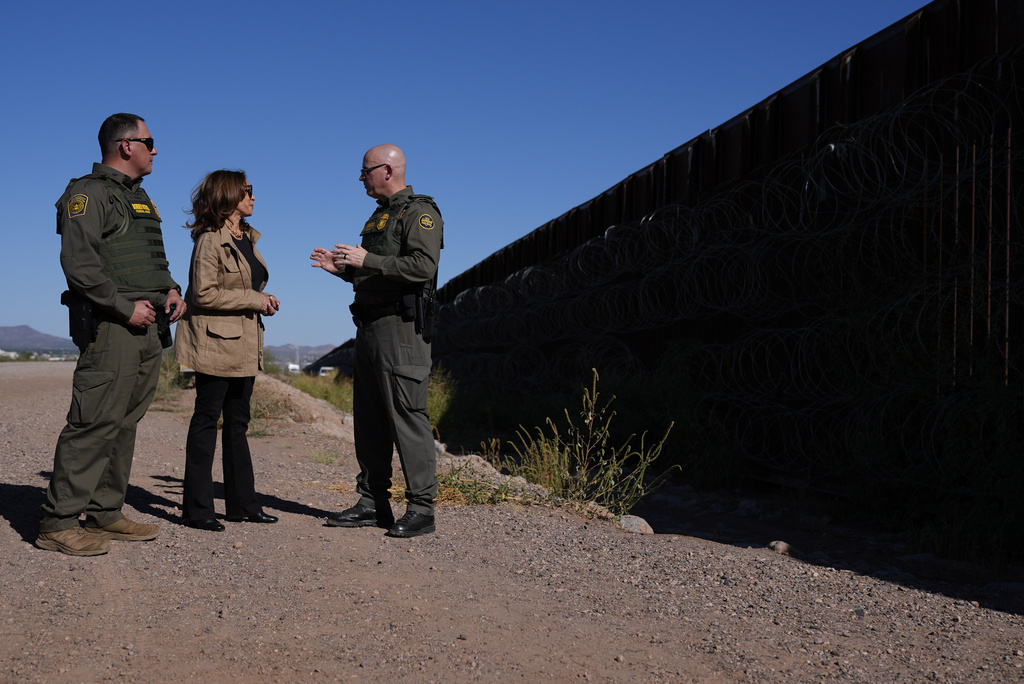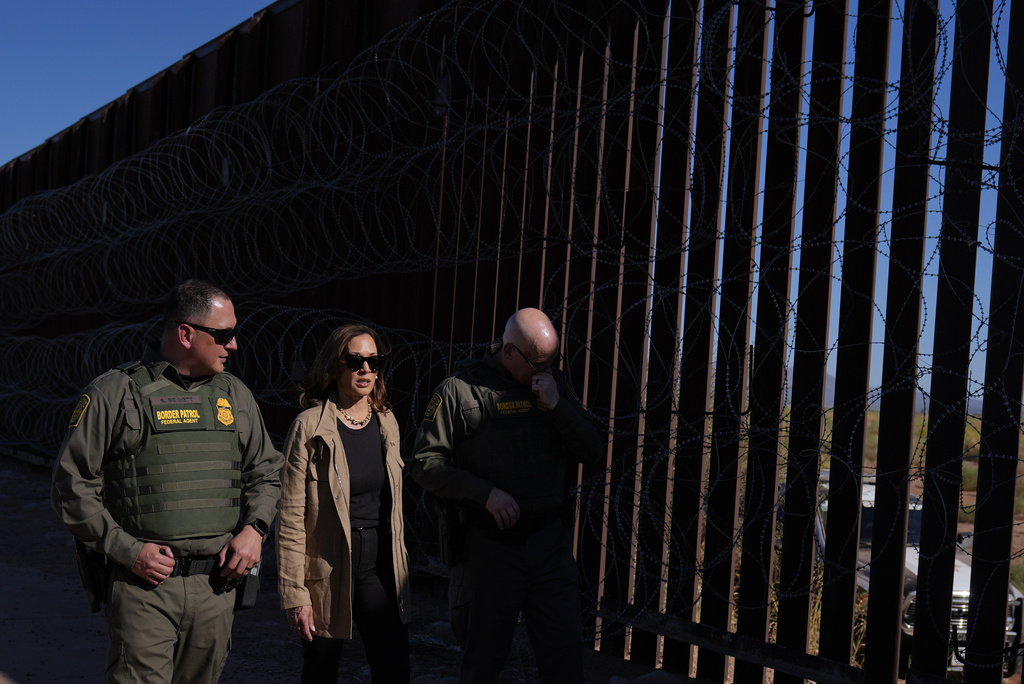Kamala Harris Visits Arizona Border to Address Immigration Crisis \ Newslooks \ Washington DC \ Mary Sidiqi \ Evening Edition \ Vice President Kamala Harris visited Arizona’s border with Mexico to emphasize her stance on illegal migration, a key issue in her presidential campaign. Harris engaged with Border Patrol officials and outlined plans to tighten asylum restrictions beyond current policies. This visit comes as she faces criticism from former President Trump on immigration, an issue where he holds an advantage with voters.

Kamala Harris Visits Arizona Border: Quick Looks
- Kamala Harris visited Arizona’s border with Mexico, emphasizing border security.
- First visit to the border since becoming Democratic presidential nominee.
- Harris walked the fence line, spoke with Border Patrol in Douglas, Arizona.
- She praised Border Patrol’s work and pledged more support for border enforcement.
- Harris to call for tighter asylum policies, exceeding Biden’s previous measures.
- Harris faces political pressure from Trump on migration policies and border security.
- Trump and GOP criticize Harris for lack of border action; Harris pushes back with new proposals.
- Harris highlights her past work on border-related prosecutions as California attorney general.
Deep Look
Vice President Kamala Harris took a high-profile trip to Arizona’s border with Mexico on Friday, aiming to present herself as strong on border security—a critical issue that has become one of her biggest vulnerabilities as she approaches the November election. The trip marks Harris’ first visit to the international boundary since becoming the Democratic nominee for president, and her appearance was meant to counter ongoing criticism from Republicans and her rival, former President Donald Trump.
Harris arrived by helicopter in Douglas, Arizona, a border town in Cochise County that has been at the center of the debate on migration. She toured a scrubby stretch of the rust-colored wall built during Barack Obama’s presidency, speaking with local Border Patrol leaders as temperatures neared 100 degrees. The 30-minute conversation revolved around the challenges faced by agents tasked with patrolling the border and preventing illegal migration and drug trafficking.
“They’ve got a tough job, and they need, rightly, support to do their job,” Harris said as she entered the Douglas port of entry for a briefing on efforts to block the flow of fentanyl and other illicit drugs into the United States. “They are very dedicated. And so I’m here to talk with them about what we can continue to do to support them. And also thank them for the hard work they do.”
This visit was part of Harris’ broader effort to reposition herself on an issue where she has faced consistent attacks from Trump and other Republicans. The Biden administration’s handling of migration and border security has long been a target of GOP criticism, with Republicans often citing it as one of the administration’s greatest failures. Harris herself has been criticized for not spending enough time visiting the border or addressing the crisis during her tenure as vice president.
In response to this criticism, Harris is expected to call for tightening asylum restrictions even beyond what President Joe Biden’s administration had implemented earlier this year. Speaking later at a packed gymnasium, she outlined her plan to further restrict asylum claims, keeping the new restrictions in place longer than the executive order Biden signed this past summer. According to a campaign official who briefed reporters aboard Air Force 2 en route to Arizona, Harris will advocate for these changes to demonstrate her resolve in addressing border security.
The official, who spoke on the condition of anonymity because Harris had not yet formally made the announcement, described this shift as part of Harris’ strategy to gain voter trust on immigration—a policy area where Trump currently holds a significant edge. During her visit, Harris met with Douglas Mayor Donald Huish, Cochise County Sheriff Mark Dannels, and County Supervisor Ann English, alongside Arizona Senator Mark Kelly and Attorney General Kris Mayes, signaling a collaborative approach to addressing border concerns.
Arizona, the only battleground state that directly borders Mexico, has faced an influx of asylum seekers, making immigration and border security central issues for its voters. The state’s unique geographic and political dynamics mean that Harris must strike a balance between tough enforcement measures and humane immigration policies, as she works to sway undecided voters and bolster her support among those who may lean towards Trump on this issue.
Trump has used every opportunity to attack Harris on migration, frequently criticizing the Biden administration’s approach and the perceived lack of attention given to the border crisis. During her campaign speeches, Harris often brings up the bipartisan immigration package that aimed to overhaul the federal system—a bill that collapsed in Congress earlier this year, largely due to Trump’s influence in urging Republicans to oppose it. Speaking about this failed effort, Harris plans to say, “The American people deserve a president who cares more about border security than playing political games,” emphasizing her commitment to finding solutions over partisanship.
In the wake of the stalled immigration legislation, the Biden administration introduced rules that limit the ability of migrants to claim asylum, especially during times when U.S. border officials declare an emergency. These rules led to a significant reduction in illegal crossings since their introduction. However, Harris intends to go further, proposing a longer-term approach to limiting asylum claims—a move designed to counter the perception that she is soft on border enforcement.
Harris also took the opportunity during her visit to remind voters of her past efforts as California’s attorney general, where she tackled crime along the border. She spoke about prosecuting drug- and human-smuggling gangs that operated across national borders, saying, “I prosecuted them in case after case, and I won.” This track record is part of Harris’ strategy to establish her credentials as tough on crime and border security.
Trump, meanwhile, has wasted no time in pushing back against Harris’ actions and words. Speaking from a manufacturing plant in Michigan on Friday, he criticized her stance on border issues, claiming that “blood is on her hands” for crimes allegedly committed by individuals who entered the U.S. illegally. He pointed to supposed data about criminals crossing the border as evidence that Harris has failed in her responsibilities. He also took a direct jab at her credibility, stating, “When Kamala speaks about the border, her credibility is less than zero.”
The Trump campaign has further countered Harris with a series of TV ads deriding her as a failed “border czar.” These ads claim that “under Harris, over 10 million” people have crossed into the U.S. illegally—a number that remains widely disputed, with various estimates showing significant differences. Importantly, Harris never officially held the title of “border czar.” Instead, her assignment was to address the “root causes” of migration, particularly in the Central American nations of El Salvador, Guatemala, and Honduras, which have historically accounted for a significant proportion of border crossers. Harris’ approach focused on long-term solutions such as encouraging multinational corporations and businesses to invest in these countries, with the aim of creating jobs and improving living conditions to reduce the incentive for people to migrate north.
Still, Trump and his supporters have continued to characterize her efforts as insufficient. Trump has repeatedly described the influx of migrants as an “invasion” and blames Harris directly for what he calls uncontrolled illegal immigration. His recent visit to a remote part of the Arizona border, where he stood in front of a pile of steel beams intended for border wall construction, was meant to contrast his hardline stance on border security with Harris’ more measured approach.
The political dynamics in Cochise County, where Douglas is located, are also a microcosm of the broader national debate on migration. Douglas is a Democratic-leaning town within a largely Republican-controlled county. The Republican majority on the Cochise County Board of Supervisors has made headlines by refusing to certify the 2022 election results, leading to criminal charges. Many local residents have strong ties to Agua Prieta, a neighboring city in Mexico, and share concerns not only about border security but also about improving the efficiency of legal crossings. This dual focus complicates the border debate, illustrating that effective policy must address both the illegal and legal dimensions of migration.
For Kamala Harris, the visit to Douglas was a key moment to showcase her commitment to border security ahead of Election Day, now less than six weeks away. By pushing for tougher asylum restrictions and highlighting her past as a prosecutor, Harris is attempting to mitigate a critical line of attack from Trump and position herself as capable of dealing with one of the most pressing issues facing the country. The trip thrusts immigration into the campaign spotlight, and with the stakes this high, Harris hopes her message resonates with voters who have yet to make up their minds on the future direction of U.S. border policy.
As the election nears, the rhetoric from both sides will likely intensify. For Harris, her challenge remains balancing a compassionate approach to the root causes of migration with the perception of toughness on border enforcement—a balance that could prove pivotal in determining her success on Election Day.
Kamala Harris Visits Arizona Kamala Harris Visits Arizona







